 |
 |
 |
| |
The effect of different types of food on the bioavailability of TMC278, an investigational NNRTI
|
| |
| |
Reported by Jules Levin
9th International Workshop on Clinical Pharmacology of HIV Therapy
April 7-9, 2008
New Orleans
HM Crauwels,1 RPG van Heeswijk,1 A Bollen,1 M Stevens,1 A Buelens,1 K Boven,2 RMW Hoetelmans1
1Tibotec BVBA, Mechelen, Belgium; 2Tibotec Inc., Yardley, PA, USA
AUTHOR CONCLUSIONS
TMC278 should be administered with a meal to enhance the absorption and exposure.
Intake of tmc278 without food or with a nutritional drink reduced the exposure by approximately 40-50% compared with intake with a standard breakfast, and should be avoided.
There was no relevant difference in the exposure of TMC278 when taken with a standard breakfast or a high-fat breakfast.
The same recommendations will be applied for the phase III trials, where TMC278 will be further evaluated using the same tablet formulation, in a dose strength of 25 mg qd.
All treatments were generally safe and well tolerated.
Abstract
Background: TMC278 is a next-generation investigational NNRTI that has
shown potent and sustained efficacy through 48 weeks in antiretroviral (ARV)-
na´ve HIV-infected patients (CROI 2007). Previous studies showed that the
absorption of TMC278 increased after intake with food. This study evaluated
the effect of intake of different types of food on the bioavailability of TMC278.
Methods: This was an open-label, randomized, four-way crossover trial in
20 HIV-negative volunteers. Participants received a single dose of a 75mg
TMC278 tablet formulation after a standard breakfast (reference; 21g fat,
533kcal), after a high-fat breakfast (56g fat, 928kcal), under fasting conditions,
and after a protein-rich nutritional drink (8g fat, 300kcal). Plasma samples
were taken from predose up to 168 hours postdose, and analyzed for
TMC278 using a validated liquid chromatography - mass spectrometry/mass
spectrometry (LC-MS/MS) method. Pharmacokinetic (PK) parameters were
calculated using non-compartmental analysis. The least square (LS) means and
associated 90% confidence interval (CI) of treatment ratios (test/reference)
were calculated based on log-transformed PK parameters.
Results:
TMC278 administered after a high-fat breakfast compared with a standard breakfast resulted in a similar maximum TMC278 plasma concentration (Cmax) (LS means ratio 0.92; 90% CI: 0.81-1.05) and area under the plasma concentration-time curve from administration until the last timepoint with a measurable concentration (AUClast) (LS means ratio 0.92; 90% CI: 0.80-1.07).
Under fasting conditions, the TMC278 Cmax decreased by 46% (LS means ratio 0.54; 90% CI: 0.43-0.69) and AUClast by 43% (LS means ratio 0.57; 90% CI: 0.46-0.72), compared with a standard breakfast.
Administration of TMC278 with a protein-rich nutritional drink resulted in similar exposures as intake without food (Cmax and AUClast both decreased by 50% compared with a standard breakfast).
The median time to reach the maximum TMC278 plasma concentration (tmax) and mean terminal half-life (t1/2) were comparable for all treatments. Median tmax ranged between 4 and 5 hours, and mean t1/2 ranged between 43 and 55 hours.
All treatments were generally well tolerated. No grade 3 or 4 adverse events (AEs) and no serious AEs were reported. There were no discontinuations due to AEs.
Conclusions: TMC278 should be taken with a meal to ensure optimal
absorption and exposure. Intake of TMC278 without food or with a protein-rich
nutritional drink reduced the exposure by approximately 40-50%, and
should be avoided. The exposures after intake with a regular or a high-fat
breakfast were comparable.
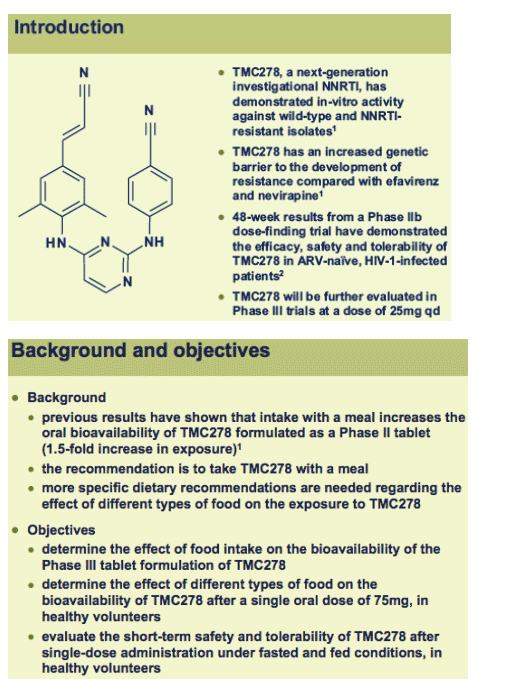
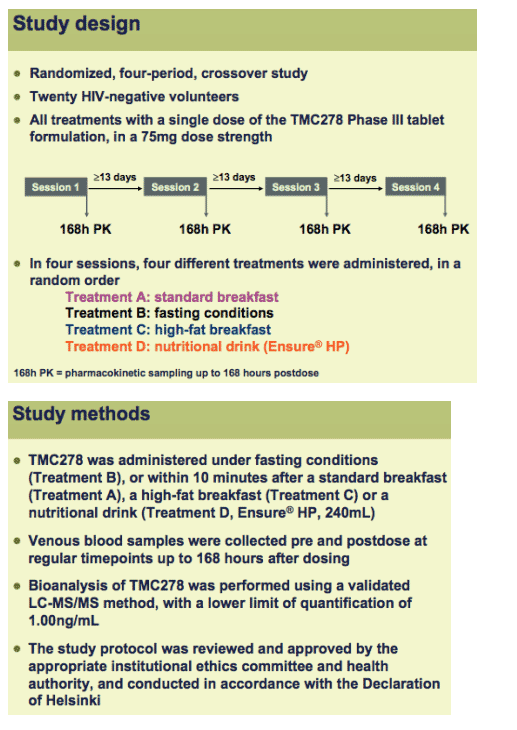
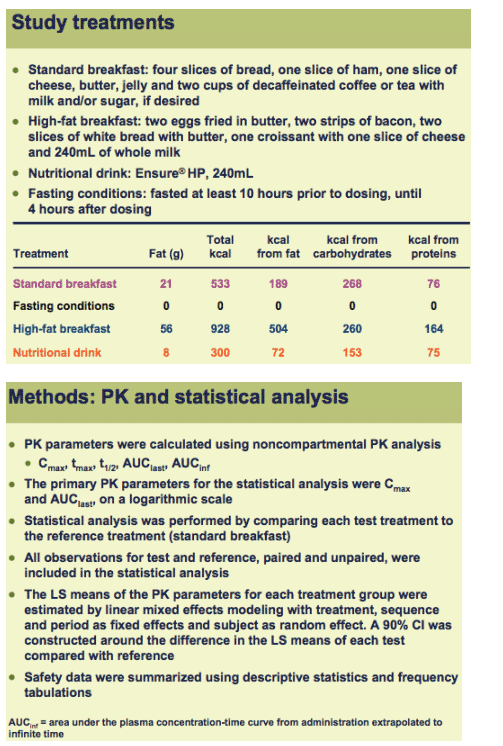
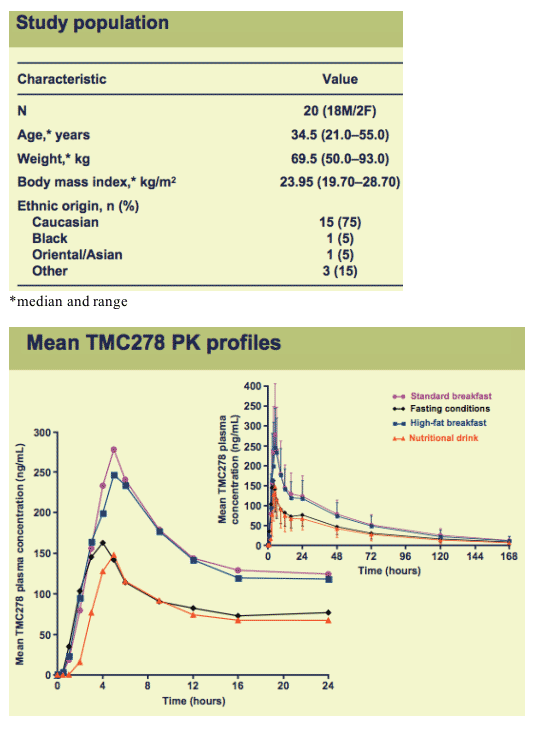
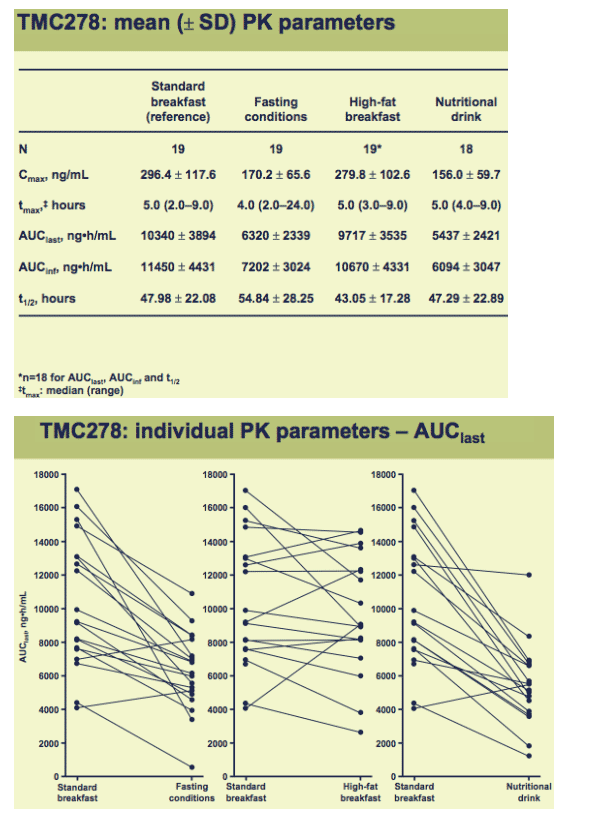
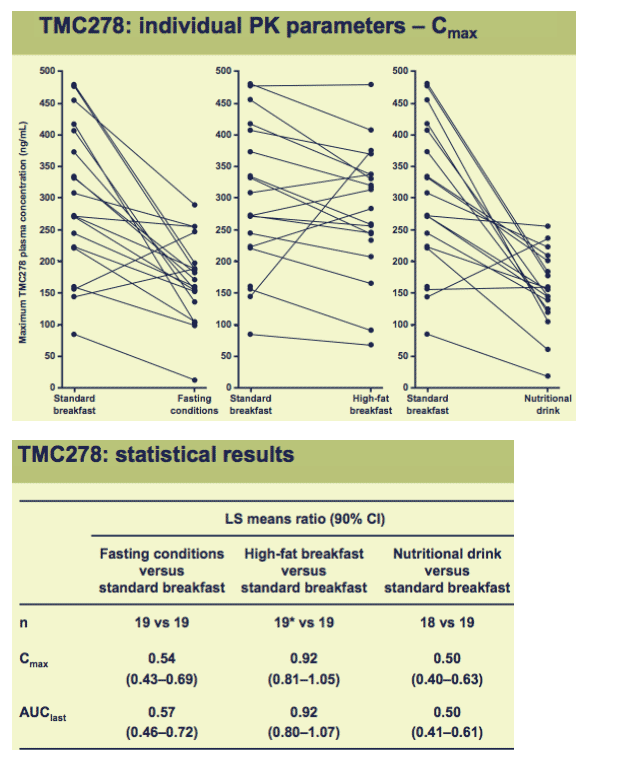
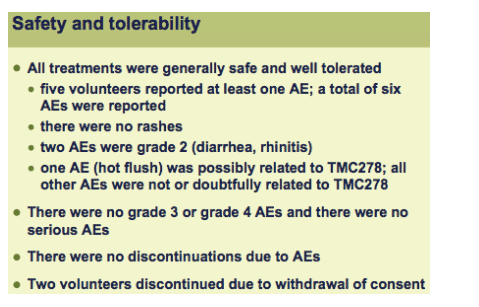
|
| |
|
 |
 |
|
|